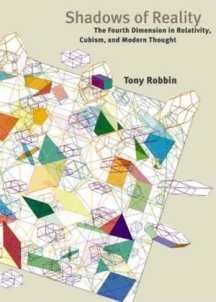Tony Robbin had started out as a painter. He created complex works filled with interwoven patterns and ambiguous figures to give the illusion of seeing more than one object in the same place at the same time.

“I was interested in ways of experiencing and depicting space—complex spaces, multiple spaces, paradoxical spaces,” Robbin recalls. His fascination with finding ways to look beyond our three-dimensional universe inevitably led him into the domain of four-dimensional geometry.
In a fashion that was typical for him, Robbin set out to learn everything he could about the fourth dimension, even hiring a tutor to introduce him to space-time and Einstein’s general theory of relativity. But it was a visit in 1979 to Brown University that persuaded him that mathematics could serve as his gateway to higher-dimensional spaces. During this visit, he saw Tom Banchoff’s pioneering, computer-generated images of hypercubes—four-dimensional analogs of cubes.
“After years of hoping to visualize the four-dimensional cube, there it was,” Robbin wrote in his 1992 book Fourfield. “By moving a joystick, I could turn the hypercube in my hand. The computer recalculated the position of the object thirty times a second, so the joystick was exquisitely sensitive to the touch, and the illusion of actually handling this beloved and mysterious object was very strong indeed.”
“For three nights, I woke frequently from dreams of the images that I had seen on Banchoff’s computer: the green screen, the quivering geometric figures,” Robbin continued. “It seemed as if these images were imprinted on my mind. I had seen the fourth dimension directly.”
“I realized that real mathematics was more liberating and richer, more complicated and more exhilarating, than my ignorant artist’s fantasies about it,” he noted. “I was dissatisfied with using artists’ tricks to depict spaces. I decided to take the plunge.”
Robbin’s immersion in mathematics led to the creation of a series of works in which welded steel frames protrude from painted canvas to represent sections of hypercubes. Because the painted lines remain fixed and the relative positions of the rods change as the viewer walks past, such a work recreates in a novel fashion the experience of seeing the multiple faces of a three-dimensional shadow cast by a rotating hypercube.
Robbin also developed a strong appreciation of what a computer can do to help visualize complicated forms. “The lens allowed us to make recorded images of the things we see,” he said. “The computer allows us to see things that we know are there but we can’t see for ourselves.”
Robbin went back to school to learn enough mathematics and computer programming to write his own software for creating images of four-dimensional geometric structures.
In later artworks, Robbin explored the dimension-bursting and space-twisting interactions of sculpture, painting, and light more fully. In some pieces, he took advantage of the shadows cast by steel-rod frameworks attached to canvas to complete four-dimensional geometric figures.
In other cases, Robbin shone red and blue light from different angles through wire frameworks, projecting colored shadows on a blank, white wall. He provided viewers with special glasses that fused the colored shadows to make figures that complete the hypercubic forms depicted in his artwork.
In his new book, Shadows of Reality, Robbin writes, “Mathematics can define and conquer the extra space and make four-dimensional geometry into a sensible world, perhaps even as sensible as the three-dimensional world.”
Robbin’s book is a provocative, illuminating adventure in a realm of many surprises, offering novel insights into both math and art history. He champions the powerful role that projective geometry, in particular, has played in the development of modern art, science, and math.
Check out Ivars Peterson’s MathTrek blog at http://blog.sciencenews.org/.






